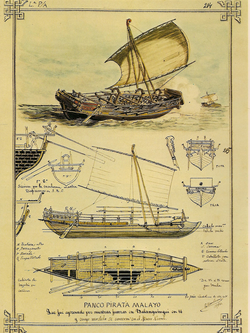Garay (ship)


Garaywere traditional nativewarshipsof theBanguinguipeople in thePhilippinesand were used by theBruneian Navy.[1]In the 18th and 19th centuries, they were commonly used forpiracyby the Banguingui andIranun peopleagainst unarmed trading ships and raids on coastal settlements in the regions surrounding theSulu Sea.
History
[edit]
Mostgaraywere built in the shipyards ofParang, Suluin the late 18th century. During the early 19th century, Banguinguigaraysquadrons regularly plagued the straits of southernPalawanfrom the months of March to November each year. They raided coastal areas in northern Borneo for slaves as well as cut off trade into theSultanate of Brunei.These attacks severely affected the economy of Brunei, leading to its decline. The Banguingui purportedly had a saying: "It is difficult to catch fish, but easy to catch Borneans."[2]
Description
[edit]Garaywere smaller, faster, and more maneuverable than the Iranunlanongwarships. They had a muchbroader beamand a somewhat round hull with a shallowdraft.They had a single tripodmain-mastmade of three bamboo poles, which was rigged with a large rectangular sail with tilted upper corners (alayar tanja). They also had aforemastand sometimes amizzenmast,which were rigged with smaller triangularcrab claw sails.When the wind was heavy, themainsailwas lowered and only theforesailand the mizzen sails were set.[3][4]

They were also propelled byoars.Largegaraycould have around 30 to 60 oars, usually arranged intotwo banks,one on top of the other. They were rowed by either people belonging to thealipincaste, or by captured slaves. The hull was partially or fully decked. The deck was made of split bamboo slats, divided into square sections that could be removed as required. Most of the length of the ship was covered by a house-like structure roofed withnipaleaves. A raised platform over a clay stove was used for cooking. At the sides of the hull were overhanging catwalks, about 1 to 2 ft (0.30 to 0.61 m) in width. The ship did not have a centralrudder,but had twosteering oarslocated near the stern.[3][4]
The largestgaraywere around 70 to 80 ft (21 to 24 m) long and could carry up to 80 men, but mostgarayaveraged at 60 to 70 ft (18 to 21 m) with around 60 men. Even smallergarayalso existed with an average crew (sakay) of 25 to 30 men.[3]Largegaraycan serve asmothershipsto smallersalisipan(a coveredbanca,shielded against arrows and spears), which could carry an additional 15 people.[3]
Garaywere led by anakuraornakuda(commander) who in turn is led by a squadron leader, thepanglima.Thejulmuri(first mate) is in charge of the crew and also controls the rudder (bausan). Another officer, thejulbatostays at the prow of the ship and watches out for reefs and enemy ships. Thejulbatois also in charge of the anchor (sao).[5]
Garaydid not possessoutriggers(unlike thelanongand otherkarakoawarships). Despite this fact,garaywere commonly incorrectly referred to asprahuorproa(bothoutrigger vessels) in historical records. However, the projecting catwalks can function as a sort of outrigger in instances where the hull was flooded, keeping the ship afloat.[3]InMalay,Javanese,andPortuguesesources,garayare also sometimes (incorrectly) referred to aspenjajap.This term, however, referred specifically topenjajap(mangaioinIranun), very long and narrow warships used mostly inNusantara.They differed fromgarayin the width of their beams (penjajapwere extremely narrow), and the fact that largepenjajapusually had outriggers and twolayar tanjasails.Garaywere also sometimes referred to generically aspanco(bangka).[3][6]
Role
[edit]Garaywere lightly armed, in comparison to thelanong.They usually only had a single large cannon (lela). While thelanongspecialized in ship-to-ship combat, thegaraywas more suited to raiding coastal villages and attacking unarmed or lightly armed trade ships.[3]
See also
[edit]- Spanish expedition to Balanguingui
- Lepa (ship)
- Balangay
- Kora kora
- History of slavery in the Muslim world
References
[edit]- ^Francis Warren, James (1981).The Sulu Zone, 1768-1898: The Dynamics of External Trade, Slavery, and Ethnicity in the Transformation of a Southeast Asian Maritime State.ISBN9789971693862.
- ^James Francis Warren (1985)."The Prahus of the Sulu Zone"(PDF).Brunei Museum Journal.6:42–45.
- ^abcdefgJames Francis Warren (2002).Iranun and Balangingi: Globalization, Maritime Raiding and the Birth of Ethnicity.NUS Press. pp. 53–56.ISBN9789971692421.
- ^abYule, Henry & Burnell, Arthur Coke (1886).Hobson-Jobson: Being a Glossary of Anglo-Indian Colloquial Words and Phrases and of Kindred Terms Etymological, Historical, Geographical and Discursive.John Murray. p. 509.
{{cite book}}:CS1 maint: multiple names: authors list (link) - ^Ricardo E. Galang (1941)."Types of Watercraft in the Philippines".The Philippine Journal of Science.75(3): 291–306.
- ^Pierre-Yves Manguin (2012)."Lancaran, Ghurab and Ghali: Mediterranean Impact on War Vessels of Early Modern Southeast Asia".In Geoff Wade & Li Tana (ed.).Anthony Reid and the Study of the Southeast Asian Past.Institute of Southeast Asian Studies. pp. 155, 158, 173.ISBN9789814311960.





